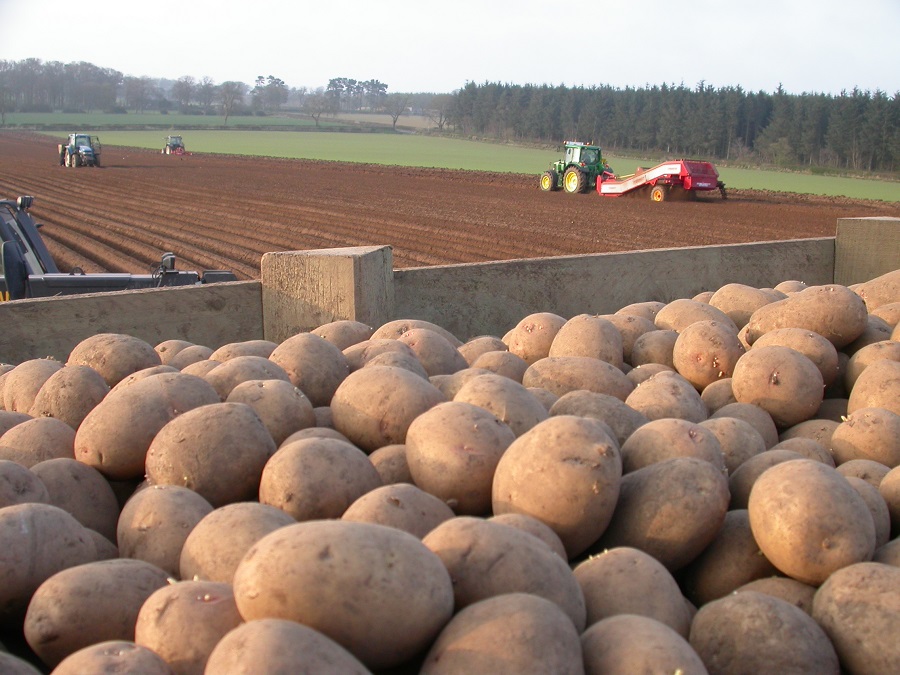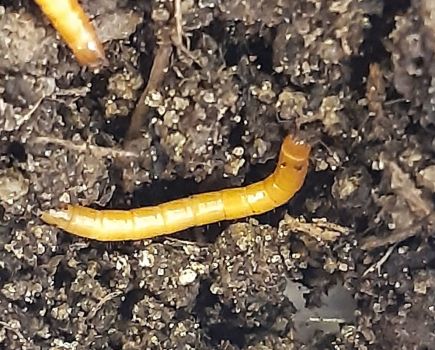Nematodes and late blight are two of the big problems facing potato growers. CPM catches up on the latest research seeking to understand their dynamics and the regulatory changes that may affect agronomy decisions in 2021.
The vast majority of soil nematodes are beneficial.
By Lucy de la Pasture
During December, AHDB hosted Agronomy Week, a virtual platform put in place of the usual annual Agronomists Conference. Highlights included a session by Dr Roy Neilson, rhizosphere ecologist and a key member of the team leading Integrated Pest and Disease Management research at James Hutton Institute (JHI).
Roy presented details of a new three-year BBSRC-funded research project being carried out at JHI which aims to establish the link between plant parasitic nematodes and blackleg, one of the most economically significant potato diseases in the UK.
He pointed out that nematodes form an important part of soil biology, with a biomass equivalent to 80% of the global human population. That equates to more than 57 billion per human being on the planet. “So great are the number of soil nematodes that the quantity of carbon they respire is roughly equivalent to 15% of carbon emissions from fossil fuels.
“While agriculture is concerned with the species that cause harm to crop plants, the vast majority of soil nematodes are beneficial,” he explained. Of the herbivorous free-living nematode (FLN) species, there are some species that have been implicated in a number of disease complexes.
“US researchers found that feeding damage caused by root lesion nematodes (Pratylenchus spp) led to a greater incidence of potato early dying (PED) disease, which is primarily caused by the fungal pathogen Verticillium dahliae which enters the wound from nematode feeding.
“In Norway, Pratylenchus has been implicated in the development of common scab. We have investigated this at JHI and found it in the lesions on tubers and while this is not evidence per se, it suggests there is a potential relationship between Pratylenchus and common scab.”
After receiving several anecdotal reports indicating an increase in the incidence of black leg in the presence of large FLN populations, the connection was investigated in pot studies at JHI. The results indicate that nematodes may be a factor in increased blackleg infection, but the big question is which species are implicated?
This is precisely what the new study is setting out to determine and looks for the potential facilitators of blackleg. The project got underway last September and will comprise a series of interlinked work packages which will take place in the glasshouse, field and employ both modelling and machine-learning technologies.
Because nematode species occur in mixed populations in the field, pot studies will take place with whole soil communities so as not to distort the relationships that occur between the different species, explained Roy.
He has suspicions that Pratylenchus, Trichodorus and Paratrichodorus species may be involved but will be keeping an open mind as there are many possible candidates. The study isn’t just limited to which FLN species may be involved in blackleg transmission, the role of aerial factors and insects will also be considered.
“We’ll be using unique real-time imaging facilities to visualise feeding of the nematodes and any interaction with blackleg,” added Roy.
Irrigation is known to enhance blackleg infections so the project will go into the field to study the interaction in work led by Dr Mark Stalham of NIAB CUF?. “As the water table moves up and down it brings nematodes with it and into close proximity to potato plants at key times in the growing season. We need to understand the interaction to determine whether there’s a simple intervention that could mitigate blackleg progression.”
Roy also explained that cover crops and bacterial communities within the rhizosphere will also be looked at to discover whether beneficial communities could also help mitigate the disease. Other questions the study hope to answer are whether there’s an impact on root architecture and if root exudates are a driver of the system as well.
“All the information generated in the trials will feed into modelling work, with the aim of constructing UK risk mapping for blackleg. Ultimately machine-learning techniques will be used to develop decision support tools for growers,” he concluded.
Giving his annual update on late blight population dynamics, JHI’s Dr David Cooke described 2020 as “an unusual season to top all unusual seasons.”
Blight was recorded as early as February, which was just one of many months that saw both rainfall and temperature anomalies. A dry period during March, April and May put the brakes on blight development before more normal rainfall patterns returned during June, July and August. September was wetter than normal for many, particularly in the East, but it wasn’t a uniform picture across the country, he commented.
“The first samples of blight were received on 26 June from the Highlands and 07 July from Shropshire. In all we recorded 94 outbreaks in 43 varieties – the top three of which were Rooster, Melody and Bambino and surprisingly didn’t feature Maris Piper. We received 681 samples at JHI of which 432 successfully genotyped.”
The trends in population change were seen again in 2020 with 36_A2 increasing slightly to 29% from 27% of the population. The fluazinam resistant strain 37_A2 also gained a bit of ground, increasing from 6 to 10%. A significant proportion of the blight population remains as 6_A1, which has remained at 36%. The once prolific 13_A2 decreased further in 2020, representing just 1% of the population in the samples received, down from 9% in 2019 and David believes it is possibly “on the way out.”
Another new blight clone was named last year as 42_A2. Since its first detection in North Wales in 2017 it has spread to infect crops in Shropshire, Cheshire and Lancashire, he adds. Fortunately, it’s not one that David feels concerned about as it has been sampled in relatively few crops.
The fungicide sensitivity testing continued last year led by Dr Alison Lees. These look at the ability of seven different active ingredients to inhibit pathogen infection and growth in the laboratory using isolates of 6_A1, 36_A2 and 37_A2, explained David.
The results showed no shifts in sensitivity or EC50 (an objective measure of the concentration of fungicide that reduces pathogen growth by 50% relative to an untreated control) in any of the three clonal lineages in detached leaf tests against cyazofamid, amisulbrom, mandipropamid, propamocarb, oxathiapiprolin and mancozeb. Fluopicolide exhibited a slightly lower impact on zoospore motility against 36_A2 than the other lineages tested but it is unclear whether this would translate into a change in field performance as the tested doses were well below field rates.
David also flagged the potential of variety resistance in late blight IPM and presented data on virulence testing that highlighted some difference in the clonal lineages. “13_A2 overcomes more major resistance genes than 6_A1 and it’s also more aggressive. For effective use of varietal resistance in the field, we need a better understanding of pathogen virulence evolution.
“37_A2 and 36_A2 aren’t as virulent as 13_A2 – they are about the same as 6_A1 (which doesn’t overcome the R2 gene). This doesn’t mean that these new clones can’t be as aggressive as 13_A2,” he clarified.
Reprieves and losses as Britain exits EU regs
The potato industry has probably suffered more than most when it comes to pesticide withdrawals but the sudden loss of Vydate (oxamyl), announced late on Christmas Eve, caught everyone by surprise, including its manufacturer Corteva Agriscience who released a statement saying, “Vydate10G has not been re-authorised for use in the UK beyond 31 Dec 2020. The decision means that Vydate 10G must not be applied to crops from 1 Jan 2021. “Stakeholder groups have submitted four applications for Emergency Authorisation approvals for use in key sectors where there are no alternative solutions. These applications are currently being evaluated.”
As things stand, CRD have granted an amendment to allow the disposal and storage of Vydate 10G until 28 Feb 2021. Corteva is currently seeking clarification from CRD with regards to the implementation of the return and disposal plans.
Following the notification AHDB quickly announced it had submitted requests for emergency authorisations (EA) for Vydate where growers lack alternative pest control options. These are for FLN in carrots and parsnips; stem and bulb nematode (Ditylenchus dipsaci) in bulb onions, garlic and shallots; FLN in potatoes; and PCN in short-season set-skin potatoes. It’s hoped these applications will go to the UK Expert Committee on Pesticides meeting in Jan.
So if AHDB’s application for an EA for Vydate isn’t granted in potatoes, what will the consequences be for growers?
Potato specialist John Sarup explains that FLN are becoming as much of a problem as PCN in some parts of the country. “FLN are the vector for tabaco rattle virus (TRV) which causes spraing but they also cause direct feeding damage to roots, which allows the entry of diseases, including rhizoctonia, blackleg and black dot.
“I believe that FLN are also implicated in potato early dying (PED) complex, which is becoming of increasing concern particularly for UK growers on light land where plenty of potato crops have been grown in the past. A number of varieties are failing to achieve their maximum potential where nematicides haven’t been used due to PED.”
John points out that growers still have access to Velum Prime, which although it doesn’t mention spraing specifically on its label, it does claim suppression of plant parasitic nematodes which encompasses FLN.
“To control spraing we need to manage the nematode and Velum will help reduce feeding from FLN and has no harvest interval, which is really useful for earlies. The downside is that it’s more expensive per ha than Vydate. Nemathorin (fosthiazate) also has a label approval for the reduction of spraing transmitted by FLN but does have a 17-week harvest interval.”
Field history and variety also play an important part in managing spraing, he highlights. “Soil moisture at tuber initiation influences the feeding of FLN. When it’s wet at tuber initiation, more spraing is likely because FLN are more mobile and are feeding at a key time for TRV infection to take place.
“The continued loss of chemistry means moving with the times and seeking other solutions,” believes John. “Optimising nutrition and good soil management, reducing compaction, can help mitigate the damage caused by FLN feeding on the roots of potato plants.”
One of the regulatory peculiarities which occurred at the end of the Brexit transition period has given mancozeb a temporary stay of execution. Any products with an approval under review on 01 Jan were automatically granted an extension of up to three years so that CRD can review the data and make its own decision.
Where the CRD made the decision not to renew Vydate on 24 Dec, just prior to its expiry date on 31 Dec, ironically mancozeb effectively slipped through the gap where the regulatory authority changed. Even though the EU decision to withdraw mancozeb was made in October, the withdrawal of authorisation notice didn’t come into effect until 04 Jan, meaning that technically Great Britain doesn’t recognise the EU decision to withdraw it until CRD reviews the data. The situation in Northern Ireland is different as it has to follow EU rules even though it comes under the UK regulatory authority.
“Most manufacturers have already decided not to manufacture blight products which have mancozeb as a partner product, these include BASF’s Invader (dimethomorph+ mancozeb); Certis’ Valbon (benthiavalicarb+ mancozeb) and Corteva’s Curzate M (metalaxyl+ mancozeb),” adds John.




